engine HONDA CLARITY PLUG-IN 2021 Owner's Manual (in English)
[x] Cancel search | Manufacturer: HONDA, Model Year: 2021, Model line: CLARITY PLUG-IN, Model: HONDA CLARITY PLUG-IN 2021Pages: 596, PDF Size: 30.45 MB
Page 13 of 596
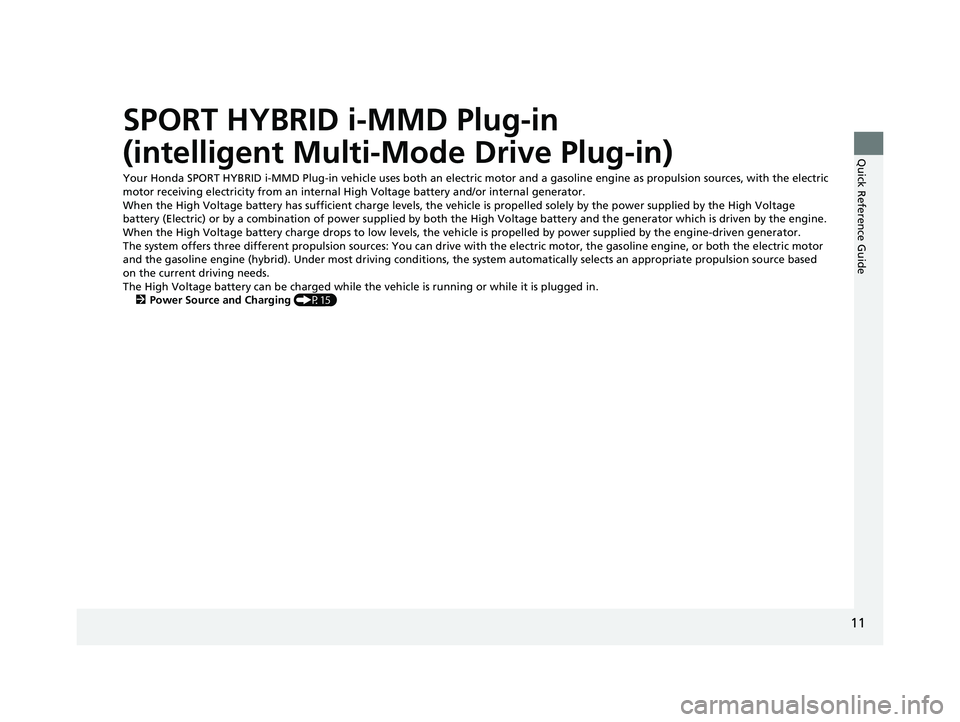
11
Quick Reference Guide
SPORT HYBRID i-MMD Plug-in
(intelligent Multi-Mode Drive Plug-in)
Your Honda SPORT HYBRID i-MMD Plug-in vehicle uses both an electric motor and a gasoline engine as propulsion sources, with the electric
motor receiving electricity from an internal Hi gh Voltage battery and/or internal generator.
When the High Voltage battery has sufficient charge levels, the vehicle is propelled solely by the power supplied by the High V oltage
battery (Electric) or by a combination of power supplied by both the High Voltage battery and the generator which is driven by the engine.
When the High Voltage battery charge drops to low levels, the ve hicle is propelled by power supplied by the engine-driven generator.
The system offers three different propulsion sources: You can dr ive with the electric motor, the gasoline engine, or both the e lectric motor
and the gasoline engine (hybrid). Under most driving conditions , the system automatically selects an appropriate propulsion source based
on the current driving needs.
The High Voltage battery can be charged while the vehicle is running or while it is plugged in. 2 Power Source and Charging (P15)
21 CLARITY PHEV CSS-31TRW6300.book 11 ページ 2020年5月19日 火曜日 午前10 時46分
Page 14 of 596
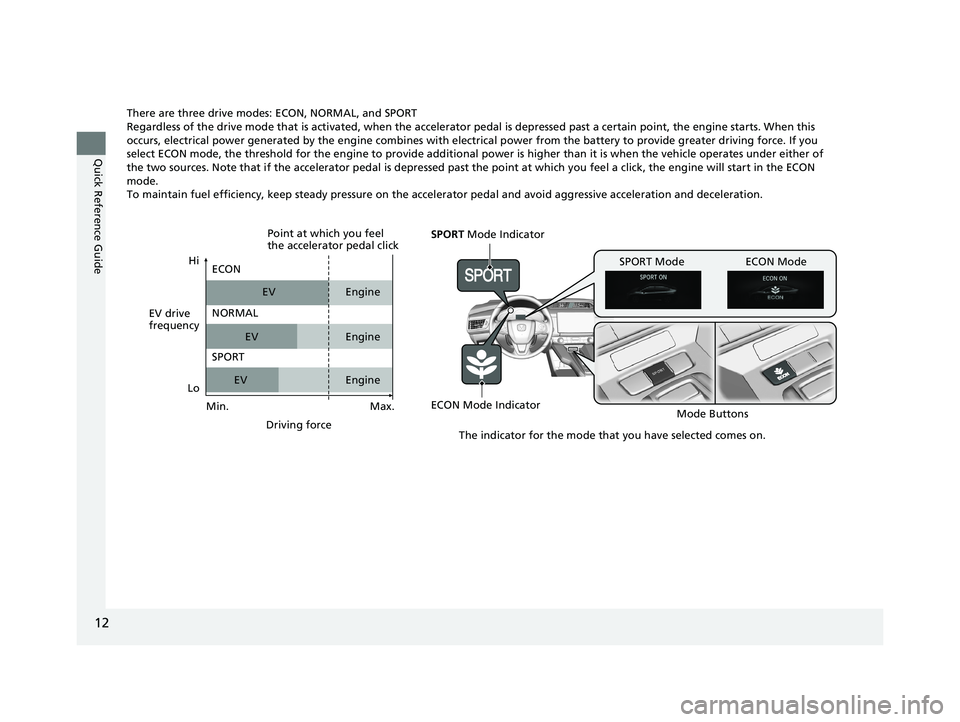
12
Quick Reference Guide
There are three drive modes: ECON, NORMAL, and SPORT
Regardless of the drive mode that is activated, when the accelerator pedal is depr essed past a certain point, the engine starts . When this
occurs, electrical power generated by the en gine combines with electrical power from the battery to provide greater driving force. If you
select ECON mode, the threshold for the engine to provide additional power is higher than it is when the vehicle operates under either of
the two sources. Note that if the accelerator pedal is depressed past the point at which you feel a click, the engine will star t in the ECON
mode.
To maintain fuel efficiency, keep steady pressure on the accelerator pedal and avoid aggressive acceleration and deceleration.
SPORT Mode Indicator
ECON Mode Indicator Mode Buttons
SPORT Mode ECON Mode
The indicator for the mode that you have selected comes on.
EV drive
frequencyHi
Max.
Driving force
ECON
NORMAL
SPORT
EV
EV
EV Engine
Engine
Engine
Point at which you feel
the accelerator pedal click
Min.
Lo
21 CLARITY PHEV CSS-31TRW6300.book 12 ページ 2020年5月19日 火曜日 午前10
時46分
Page 15 of 596
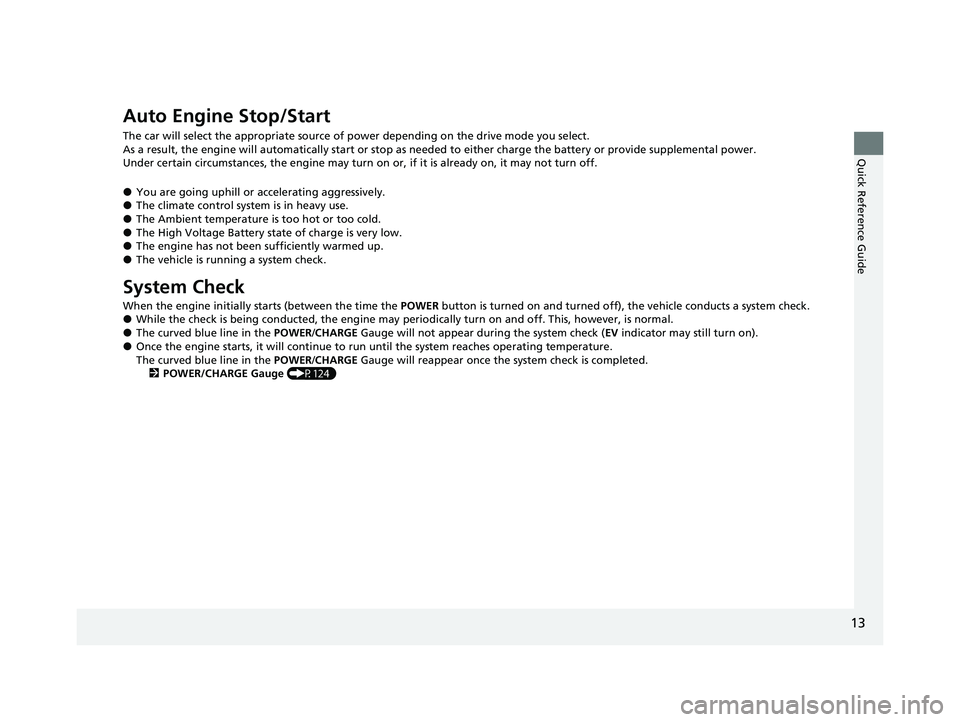
13
Quick Reference Guide
Auto Engine Stop/Start
The car will select the appropriate source of power depending on the drive mode you select.
As a result, the engine will automatically start or stop as needed to either charge the battery or provide supplemental power.
Under certain circumstances, the engine may turn on or, if it is already on, it may not turn off.
●You are going uphill or accelerating aggressively.●The climate control system is in heavy use.●The Ambient temperature is too hot or too cold.●The High Voltage Battery state of charge is very low.●The engine has not been sufficiently warmed up.●The vehicle is running a system check.
System Check
When the engine initially starts (between the time the POWER button is turned on and turned of f), the vehicle conducts a system check.●While the check is being conducted, the engine may periodically turn on and off. This, however, is normal.●The curved blue line in the POWER/CHARGE Gauge will not appear during the system check ( EV indicator may still turn on).●Once the engine starts, it will continue to run until the system reaches operating temperature.
The curved blue line in the POWER/CHARGE Gauge will reappear once the system check is completed.
2 POWER/CHARGE Gauge (P124)
21 CLARITY PHEV CSS-31TRW6300.book 13 ページ 2020年5月19日 火曜日 午前10 時46分
Page 16 of 596
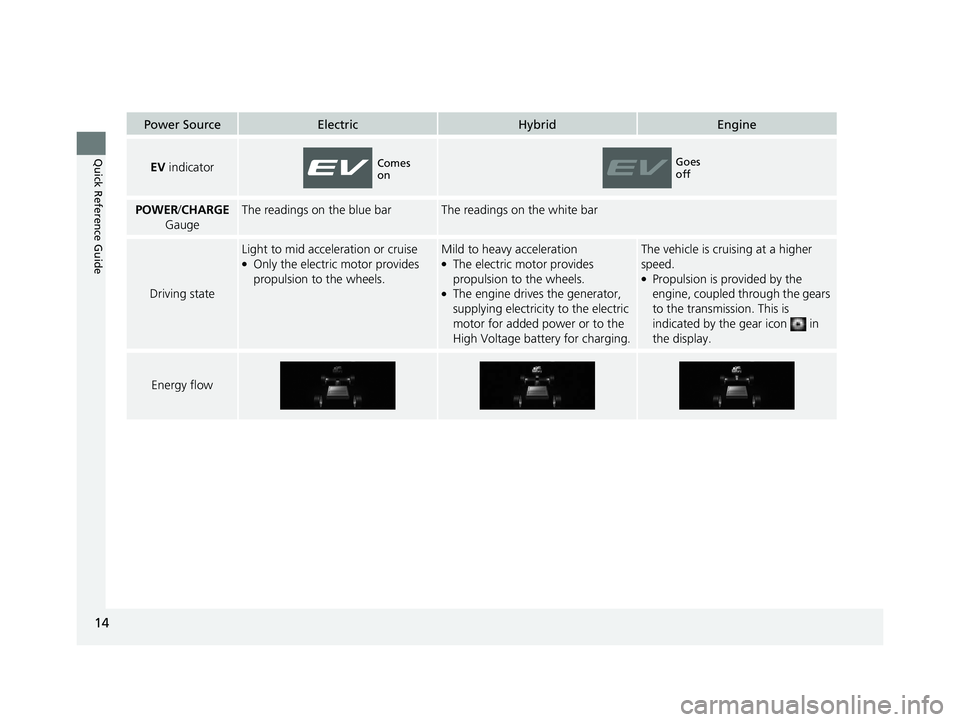
14
Quick Reference Guide
Power SourceElectricHybridEngine
EV indicator
POWER /CHARGE
GaugeThe readings on the blue barThe readings on the white bar
Driving state
Light to mid acceleration or cruise●Only the electric motor provides
propulsion to the wheels.
Mild to heavy acceleration●The electric motor provides
propulsion to the wheels.
●The engine drives the generator,
supplying electricity to the electric
motor for added power or to the
High Voltage battery for charging.
The vehicle is cruising at a higher
speed.
●Propulsion is provided by the
engine, coupled through the gears
to the transmission. This is
indicated by the gear icon in
the display.
Energy flow
Comes
onGoes
off
21 CLARITY PHEV CSS-31TRW6300.book 14 ページ 2020年5月19日 火曜日 午前10 時46分
Page 17 of 596
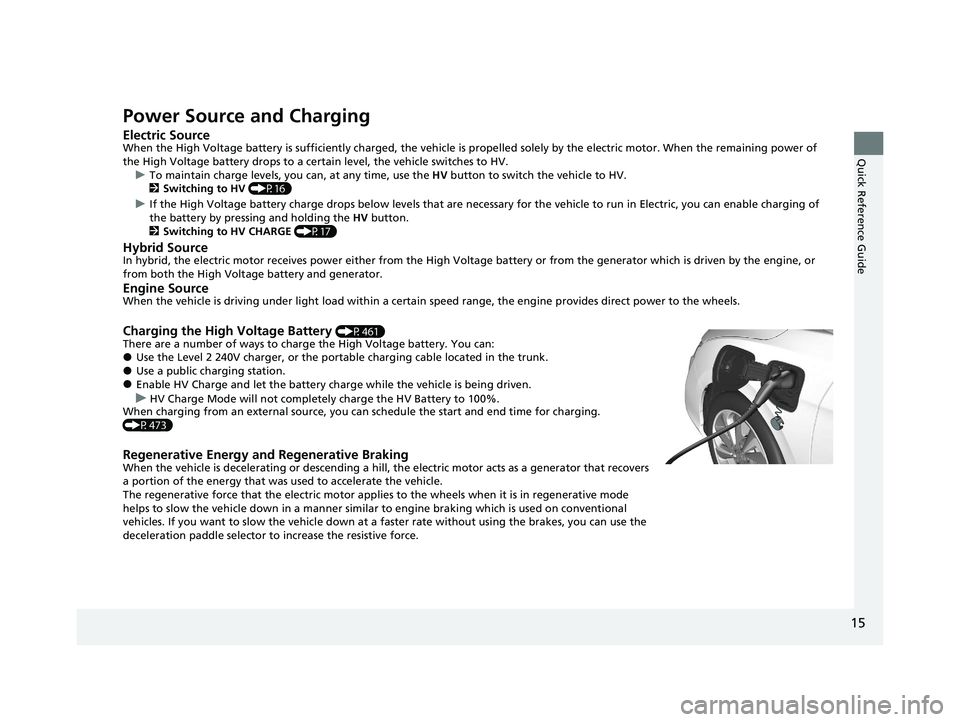
15
Quick Reference Guide
Power Source and Charging
Electric SourceWhen the High Voltage battery is sufficiently charged, the vehicle is propelled solely by the electric motor. When the remaining power of
the High Voltage battery drops to a certain level, the vehicle switches to HV. u To maintain charge levels, you can, at any time, use the HV button to switch the vehicle to HV.
2 Switching to HV (P16)
u If the High Voltage battery charge drops below levels that are necessary for the vehicle to run in Electric, you can enable charging of
the battery by pressing and holding the HV button.
2 Switching to HV CHARGE (P17)
Hybrid SourceIn hybrid, the electric motor receives powe r either from the High Voltage battery or from the generator which is driven by the engine, or
from both the High Volt age battery and generator.
Engine SourceWhen the vehicle is driving under light load within a certain speed range, the engine provides direct power to the wheels.
Charging the High Voltage Battery (P461)
There are a number of ways to charge the High Voltage battery. You can:
●Use the Level 2 240V charger, or the portable charging cable located in the trunk.●Use a public charging station.●Enable HV Charge and let the battery charge while the vehicle is being driven.
uHV Charge Mode will not completely charge the HV Battery to 100%.
When charging from an external source, you ca n schedule the start and end time for charging.
(P473)
Regenerative Energy and Regenerative BrakingWhen the vehicle is decelerating or descending a hill, the electric motor acts as a generator that recovers
a portion of the energy that was used to accelerate the vehicle.
The regenerative force that the electric motor applie s to the wheels when it is in regenerative mode
helps to slow the vehicle down in a manner similar to engine braking which is used on conventional
vehicles. If you want to slow the vehicle down at a faster rate without using the brakes, you can use the
deceleration paddle selector to increase the resistive force.
21 CLARITY PHEV CSS-31TRW6300.book 15 ページ 2020年5月19日 火曜日 午前10 時46分
Page 18 of 596
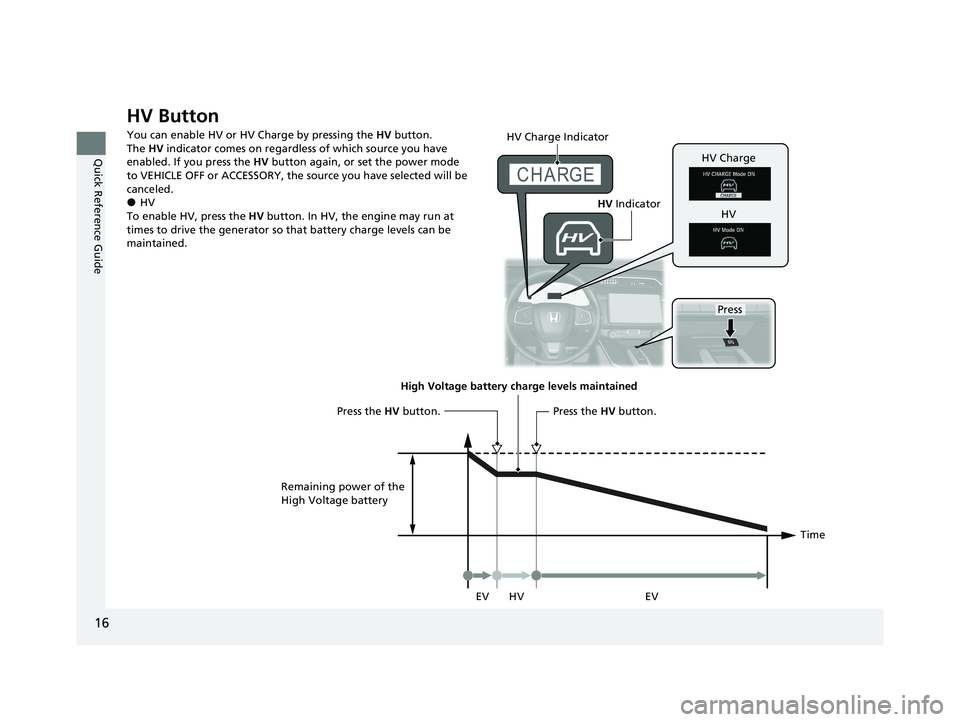
16
Quick Reference Guide
HV Button
You can enable HV or HV Charge by pressing the HV button.
The HV indicator comes on regardless of which source you have
enabled. If you press the HV button again, or set the power mode
to VEHICLE OFF or ACCESSORY, the source you have selected will be
canceled.
●HV
To enable HV, press the HV button. In HV, the engine may run at
times to drive the generator so that battery charge levels can be
maintained.
Press
HV Charge Indicator
HV
Indicator
HV Charge
HV
Time
High Voltage battery charge levels maintained
HV
Remaining power of the
High Voltage battery
Press the
HV button.Press the HV button.
EV EV
21 CLARITY PHEV CSS-31TRW6300.book 16 ページ 2020年5月19日 火曜日 午前10 時46分
Page 19 of 596
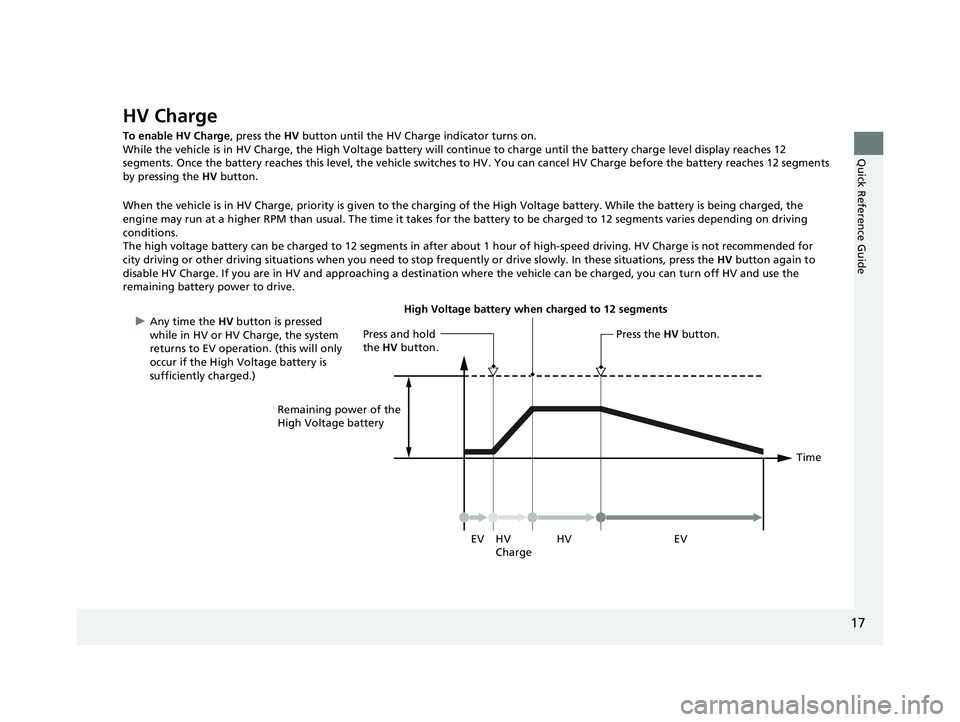
17
Quick Reference Guide
HV Charge
To enable HV Charge, press the HV button until the HV Charge indicator turns on.
While the vehicle is in HV Charge, the High Voltage battery will continue to charge until the battery charge level display reac hes 12
segments. Once the battery reaches this leve l, the vehicle switches to HV. You can cancel HV Charge before the battery reaches 12 segments
by pressing the HV button.
When the vehicle is in HV Charge, priority is given to the charging of the High Voltage battery. While the battery is being charged, the
engine may run at a higher RPM than usual. The time it takes for the battery to be charged to 12 segments varies depending on d riving
conditions.
The high voltage battery can be charged to 12 segments in after about 1 hour of high-speed driving. HV Charge is not recommende d for
city driving or other driving situations when you need to stop frequently or driv e slowly. In these situations, press the HV button again to
disable HV Charge. If you are in HV and approaching a destination where the vehicle can be charged, you can turn off HV and use the
remaining battery power to drive.
Time
High Voltage battery when charged to 12 segments
HV
Charge
Remaining power of the
High Voltage battery
Press and hold
the HV
button.Press the HV button.
EV EV
HV
u
Any time the HV button is pressed
while in HV or HV Charge, the system
returns to EV operation. (this will only
occur if the High Voltage battery is
sufficiently charged.)
21 CLARITY PHEV CSS-31TRW6300.book 17 ページ 2020年5月19日 火曜日 午前10 時46分
Page 20 of 596
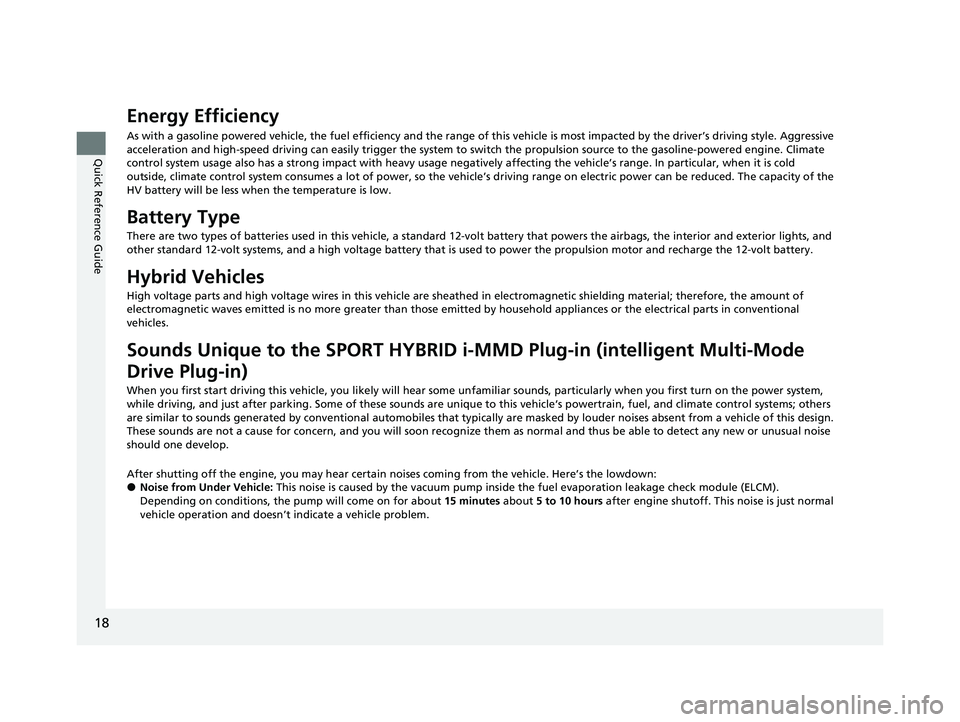
18
Quick Reference Guide
Energy Efficiency
As with a gasoline powered vehicle, the fuel efficiency and the range of this vehicle is most impacted by the driver’s driving style. Aggressive
acceleration and high-speed driving can easily trigger the system to switch the propulsion source to the gasoline-powered engin e. Climate
control system usage also has a strong impact with heavy usage ne gatively affecting the vehicle’s range. In particular, when it is cold
outside, climate control system consumes a lot of power, so th e vehicle’s driving range on electric power can be reduced. The c apacity of the
HV battery will be less when the temperature is low.
Battery Type
There are two types of batteries used in this vehicle, a standa rd 12-volt battery that powers the airbags, the interior and exterior lights, and
other standard 12-volt systems, and a high voltage battery that is used to power the propulsion motor and recharge the 12-volt battery.
Hybrid Vehicles
High voltage parts and high voltag e wires in this vehicle are sheathed in electromagnetic shielding material; therefore, the am ount of
electromagnetic waves emitted is no more gr eater than those emitted by household appliances or the electrical parts in conventional
vehicles.
Sounds Unique to the SP ORT HYBRID i-MMD Plug-in (intelligent Multi-Mode
Drive Plug-in)
When you first start driving this vehicle, you likely will hear some unfamiliar sounds, particularly when you first turn on the power system,
while driving, and just after parking. Some of these sounds are unique to this vehicle‘s powertrain, fuel, and climate control systems; others
are similar to sounds generated by conventional automobiles that typically are masked by louder noises absent from a vehicle of this design.
These sounds are not a cause for concern, and you will soon recognize them as normal and thus be able to detect any new or unus ual noise
should one develop.
After shutting off the engi ne, you may hear certain noises coming from the vehicle. Here’s the lowdown:
●Noise from Under Vehicle: This noise is caused by the vacuum pump inside the fuel evaporation leakage check module (ELCM).
Depending on conditions, the pump will come on for about 15 minutes about 5 to 10 hours after engine shutoff. This noise is just normal
vehicle operation and doesn’t indicate a vehicle problem.
21 CLARITY PHEV CSS-31TRW6300.book 18 ページ 2020年5月19日 火曜日 午前10 時46分
Page 24 of 596
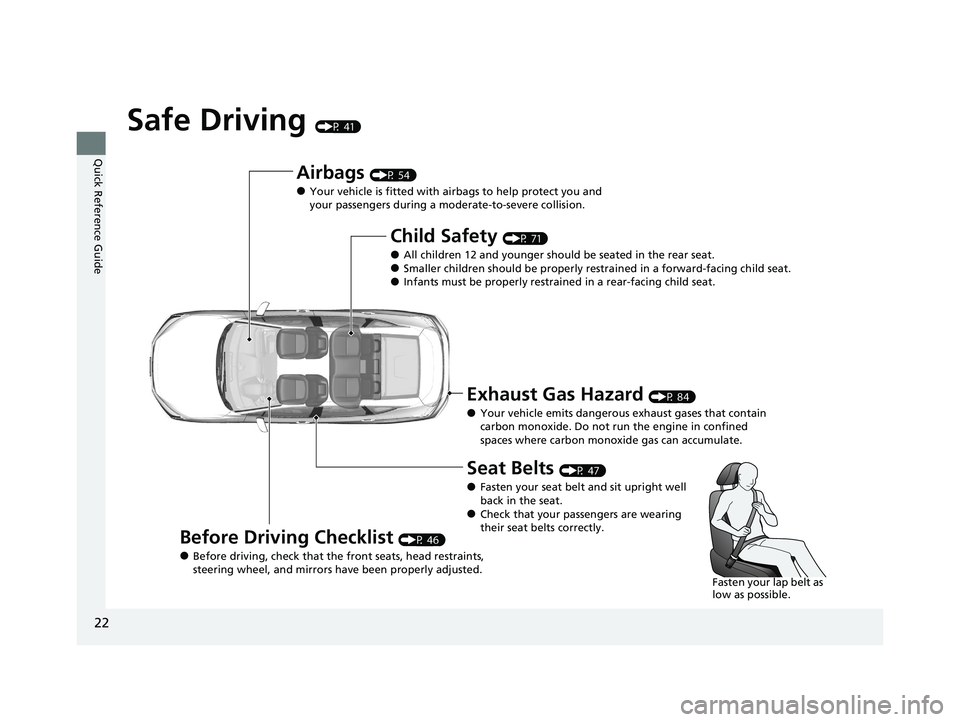
22
Quick Reference Guide
Safe Driving (P 41)
Airbags (P 54)
●Your vehicle is fitted with airbags to help protect you and
your passengers during a moderate-to-severe collision.
Child Safety (P 71)
●All children 12 and younger should be seated in the rear seat.●Smaller children should be properly restra ined in a forward-facing child seat.●Infants must be properly restrained in a rear-facing child seat.
Before Driving Checklist (P 46)
●Before driving, check that the front seats, head restraints,
steering wheel, and mirrors have been properly adjusted.
Seat Belts (P 47)
●Fasten your seat belt and sit upright well
back in the seat.
●Check that your passengers are wearing
their seat belts correctly.
Fasten your lap belt as
low as possible.
Exhaust Gas Hazard (P 84)
●Your vehicle emits dangerous exhaust gases that contain
carbon monoxide. Do not run the engine in confined
spaces where carbon monoxide gas can accumulate.
21 CLARITY PHEV CSS-31TRW6300.book 22 ページ 2020年5月19日 火曜日 午前10 時46分
Page 34 of 596
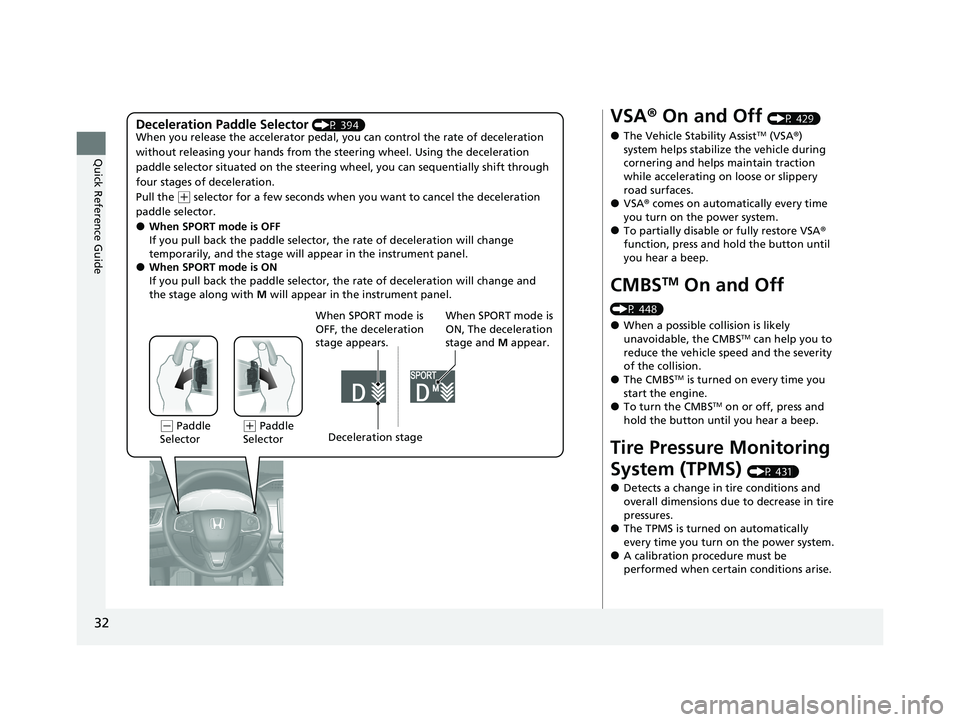
32
Quick Reference Guide
Deceleration Paddle Selector (P 394)
When you release the accelerator pedal, yo u can control the rate of deceleration
without releasing your hands from the steering wheel. Using the deceleration
paddle selector situated on the steering wheel, you can sequentially shift through
four stages of deceleration.
Pull the
( + selector for a few seconds when yo u want to cancel the deceleration
paddle selector.
●When SPORT mode is OFF
If you pull back the paddle selector, the rate of deceleration will change
temporarily, and the stage will ap pear in the instrument panel.
●When SPORT mode is ON
If you pull back the paddle selector, the rate of deceleration will change and
the stage along with M will appear in the instrument panel.
When SPORT mode is
OFF, the deceleration
stage appears. When SPORT mode is
ON, The deceleration
stage and
M appear.
(- Paddle
Selector( + Paddle
Selector Deceleration stage
VSA
® On and Off (P 429)
●The Vehicle Stability AssistTM (VSA ®)
system helps stabilize the vehicle during
cornering and helps maintain traction
while accelerating on loose or slippery
road surfaces.
●VSA ® comes on automatically every time
you turn on the power system.
●To partially disable or fully restore VSA ®
function, press and hold the button until
you hear a beep.
CMBSTM On and Off
(P 448)
●When a possible collision is likely
unavoidable, the CMBSTM can help you to
reduce the vehicle sp eed and the severity
of the collision.
●The CMBSTM is turned on every time you
start the engine.
●To turn the CMBSTM on or off, press and
hold the button until you hear a beep.
Tire Pressure Monitoring
System (TPMS)
(P 431)
●Detects a change in tire conditions and
overall dimensions due to decrease in tire
pressures.
●The TPMS is turned on automatically
every time you turn on the power system.
●A calibration procedure must be
performed when certain conditions arise.
21 CLARITY PHEV CSS-31TRW6300.book 32 ページ 2020年5月19日 火曜日 午前10 時46分